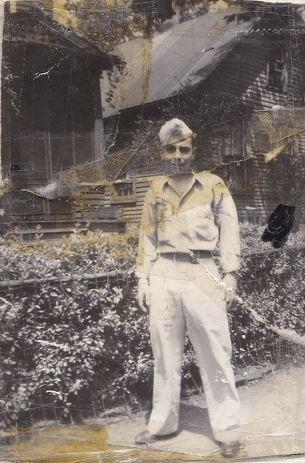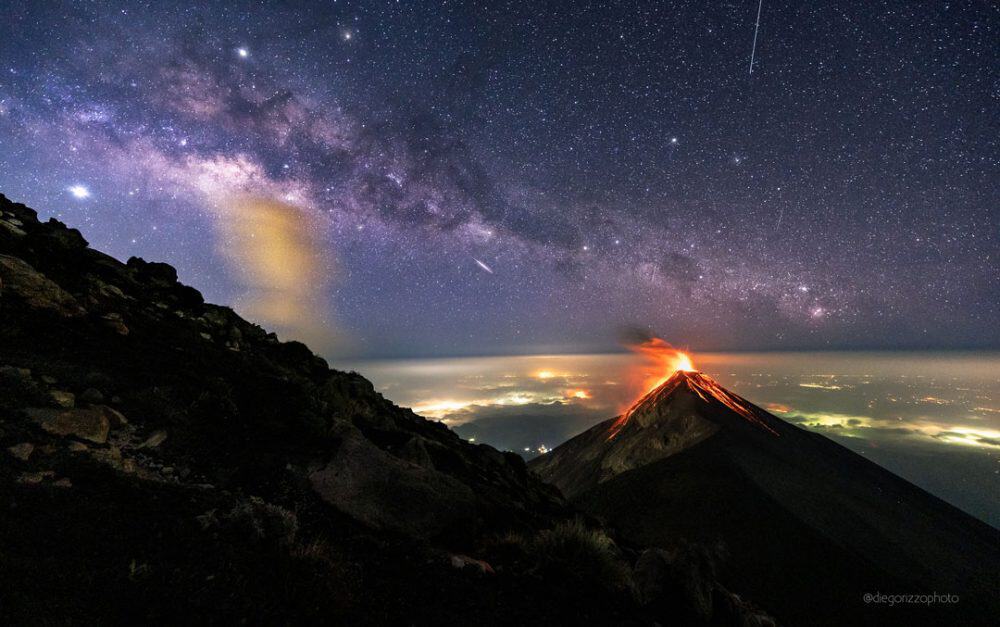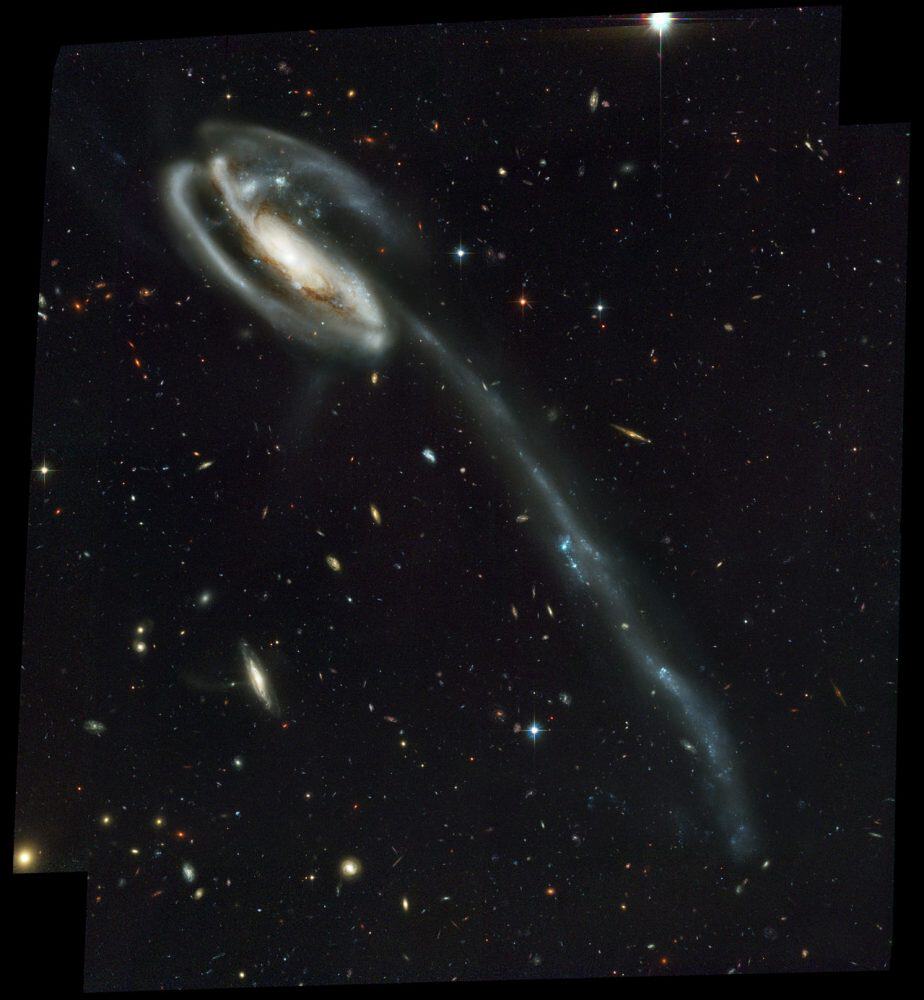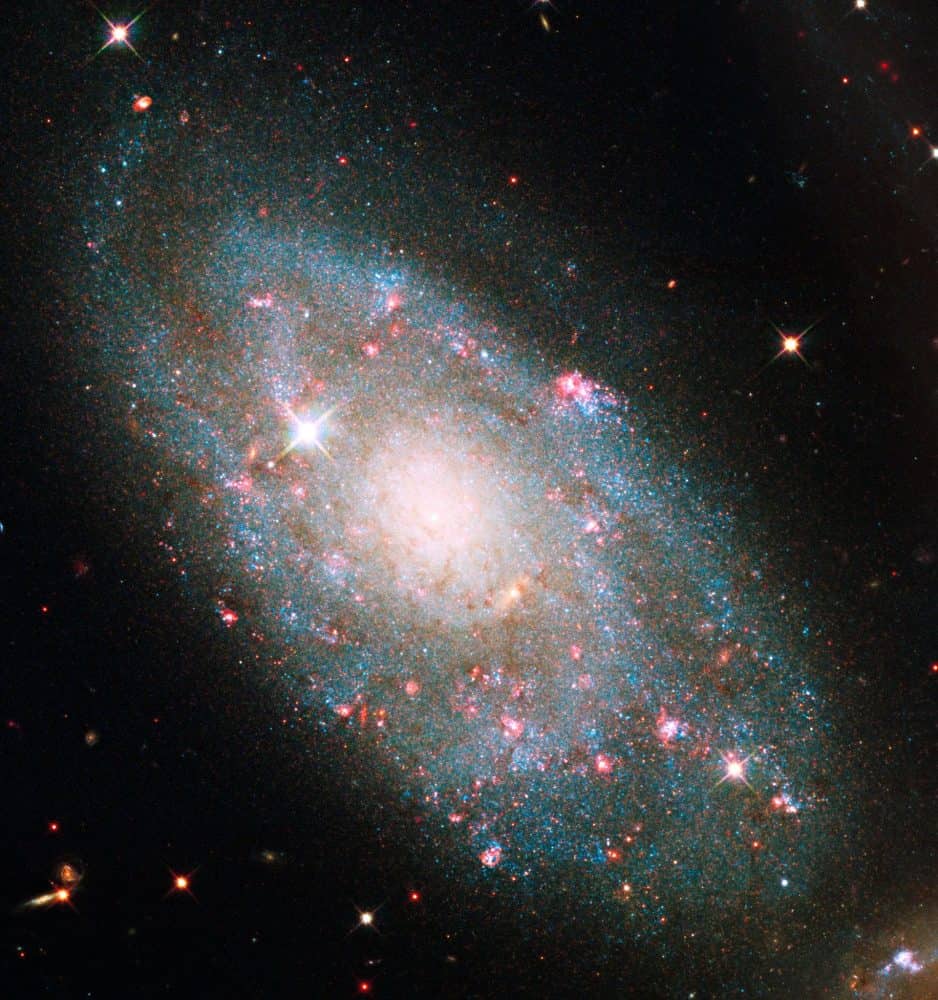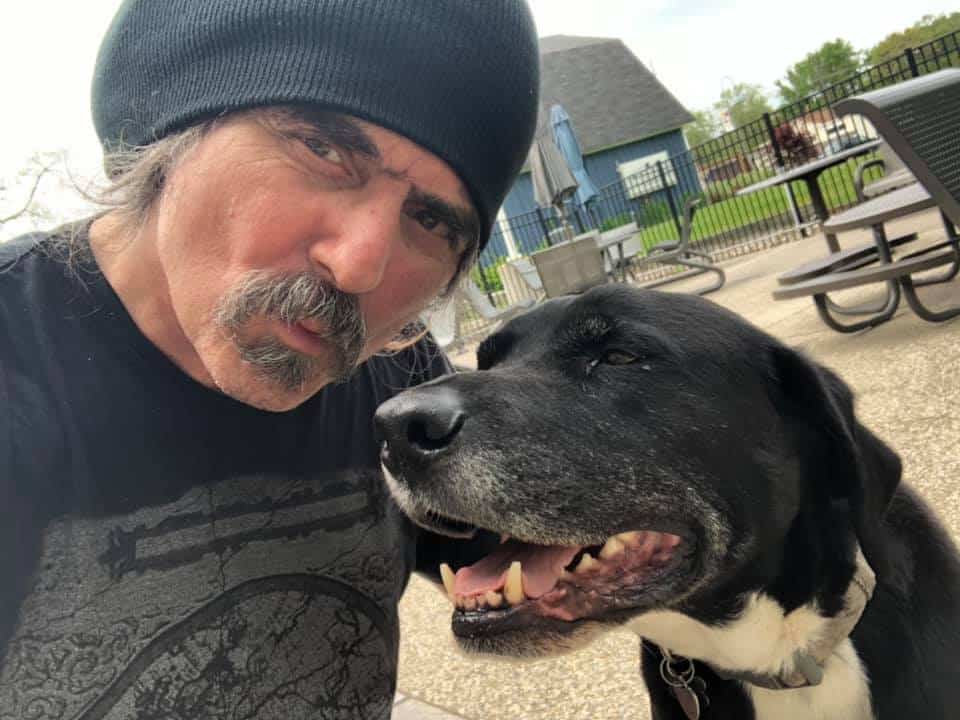Blog
https://www.youtube.com/watch?v=KQPyk4OUkeA&list=PLEB3LPVcGcWZ0hsQ5_jgSMhawAnDzy1io&index=2&t=0s
more...My dad Mike LaBriola as a teenager and soldier during WWII. He was stationed in Italy his place of birth. Now fighting the Nazi/Mussolini occupation as an American soldier. Pictured here in Blue Island, Ill
more...Volcan de Fuego is an active stratovolcano in Guatemala, on the borders of Chimaltenango, Escuintla and Sacatepéquez departments. It sits about 16 kilometres (9.9 mi) west of Antigua, On the land of the featured image, for example, the Volcano of Fire (Volcán de Fuego) is seen erupting topped by red-hot, wind-blown ash and with streams of glowing lava running down its side. Lights from neighboring towns are seen through a thin haze below. In the sky, though, the central plane of our Milky Way Galaxy runs diagonally from the upper left, with a fleeting meteor just below, and the trail of a satellite to the upper right. The planet Jupiter also appears toward the upper left, with the bright star Antares just to its right. Much of the land and the sky were captured together in a single, well-timed, 25-second exposure taken in mid-April from the side of Fuego‘s sister volcano Acatenango in Guatemala. The image of the meteor, though, was captured in a similar frame taken about 30 minutes earlier — when the volanic eruption was not as photogenic — and added later digitally.
more...Dee Dee Bridgewater (née Denise Garrett, May 27, 1950) is an American jazz singer. She is a three-time Grammy Award-winning singer-songwriter, as well as a Tony Award-winning stage actress. For 23 years, she was the host of National Public Radio’s syndicated radio show JazzSet with Dee Dee Bridgewater. She is a United Nations Goodwill Ambassador for the Food and Agriculture Organization.
Born Denise Eileen Garrett in Memphis, Tennessee, she was raised Catholic in Flint, Michigan. Her father, Matthew Garrett, was a jazz trumpeter and teacher at Manassas High School, and through his playing, she was exposed to jazz early on. At the age of sixteen, she was a member of a Rock and Rhythm ‘n’ Blues trio, singing in clubs in Michigan. At 18, she studied at Michigan State University before she went to the University of Illinois at Urbana-Champaign. With the school’s jazz band, she toured the Soviet Union in 1969.
The next year, she met trumpeter Cecil Bridgewater, and after their marriage, they moved to New York City, where Cecil played in Horace Silver‘s band. In the early 1970s, Bridgewater joined the Thad Jones-Mel Lewis Jazz Orchestra as lead vocalist. This marked the beginning of her jazz career, and she performed with many of the great jazz musicians of the time, such as Sonny Rollins, Dizzy Gillespie, Dexter Gordon, Max Roach, Rahsaan Roland Kirk and others. She performed at the Monterey Jazz Festival in 1973. In 1974, her first solo album, entitled Afro Blue, appeared, and she performed on Broadway in the musical The Wiz. For her role as Glinda the Good Witch she won a Tony Award in 1975 as “Best Featured Actress”, and the musical also won the 1976 Grammy Award for Best Musical Show Album.
more...Niels-Henning Ørsted Pedersen (Danish pronunciation: [nelsˈhɛneŋ ˈɶɐ̯stəð ˈpʰɛðɐsn̩], 27 May 1946 – 19 April 2005), often known as NHØP, was a Danish jazz upright bassist known for his technique and musical approach.
Ørsted Pedersen was born in Osted, near Roskilde, on the Danish island of Zealand, the son of a church organist. As a child, Ørsted Pedersen played piano, but from the age of 13, he started learning to play upright bass and at the age of 14, while studying, he began his professional jazz career in Denmark with his first band, Jazzkvintet 60 (Danish for Jazz Quintet 60). By the age of fifteen, he had the ability to accompany leading musicians at nightclubs, working regularly at Copenhagen’s Jazzhus Montmartre, after his debut there on New Year’s Eve 1961, when he was only 15. When seventeen, he had already turned down an offer to join the Count Basie orchestra, mainly because he was too young to get legal permission to live and work as a musician in the United States.
The Montmartre was a regular stop-off for touring American Jazz stars, and as a member of the house band, the young Ørsted Pedersen performed with saxophonists such as Sonny Rollins, Dexter Gordon, Rahsaan Roland Kirk and Stan Getz, and pianist Bill Evans, with whom he toured in Europe in 1965. During the 1960s, Ørsted Pedersen played with a series of other important American jazzmen who were touring or resident in Denmark, including Ben Webster, Brew Moore, Bud Powell, Count Basie, Roy Eldridge, Dizzy Gillespie, Jackie McLean, and vocalist Ella Fitzgerald. He also played with Jean-Luc Ponty, and became the bassist of choice whenever a big-name musician was touring Copenhagen.
https://www.youtube.com/watch?v=vZrQIn23018
more...Clifford Everett “Bud” Shank, Jr. (May 27, 1926 – April 2, 2009) was an American alto saxophonist and flautist. He rose to prominence in the early 1950s playing lead alto and flute in Stan Kenton‘s Innovations in Modern Music Orchestra and throughout the decade worked in various small jazz combos. He spent the 1960s as a first-call studio musician in Hollywood. In the 1970s and 1980s, he performed regularly with the L. A. Four. Shank ultimately abandoned the flute to focus exclusively on playing jazz on the alto saxophone. He also recorded on tenor and baritone sax. He is also well known for the alto flute solo on the song “California Dreamin’” recorded by The Mamas & the Papas in 1965.
Bud Shank was born in Dayton, Ohio. He began with clarinet in Vandalia, Ohio, but had switched to saxophone before attending the University of North Carolina. While at UNC, Shank was initiated into the Pi Kappa Alpha Fraternity. In 1946 he worked with Charlie Barnet before moving on to Kenton and the West coast jazz scene. He also had a strong interest in what might now be termed world music, playing Brazilian-influenced jazz with Laurindo Almeida in 1953–54.
more...A colliding galaxy dubbed the “Tadpole” (catalog name UGC10214) is set against a rich tapestry of 6,000 galaxies. The Tadpole, with its long tail of stars, looks like a runaway pinwheel firework, unlike the textbook images of stately spiral galaxies. Its distorted shape was caused by a small interloper, a very blue, compact galaxy visible near the more massive Tadpole. The Tadpole resides about 420 million light-years away in the constellation Draco. Seen shining through the Tadpole’s disk, the tiny intruder is likely a hit-and-run galaxy that is now leaving the scene of the accident. Strong gravitational forces from the interaction created the long tail of debris, consisting of stars and gas that stretch out more than 280,000 light-years.
more...Stephanie Lynn “Stevie” Nicks (born May 26, 1948 Phoenix, AZ) is an American singer and songwriter. Nicks is best known for her work as a songwriter and vocalist with Fleetwood Mac, and also for her chart-topping solo career. She is known for her distinctive voice, mystical stage persona and poetic, symbolic lyrics. Collectively, her work both as a member of Fleetwood Mac and as a solo artist has produced over forty top 50 hits and sold over 140 million records, making her one of the best-selling music acts of all time with Fleetwood Mac.
Nicks joined Fleetwood Mac in 1975 along with her then boyfriend, Lindsey Buckingham. Rumours, Fleetwood Mac’s second album after the incorporation of Nicks and Buckingham, was the best-selling album of the year of its release and to date has sold over 40 million copies worldwide, making it the fifth biggest-selling studio album of all time. The album remained at number one on the American albums chart for 31 weeks and reached number one in various countries worldwide. The album won the Grammy Award for Album of the Year in 1978. It produced four US Billboard Hot 100top-ten singles, with Nicks’s “Dreams” being the band’s first and only Billboard Hot 100 number-one hit.
In 1981, while remaining a member of Fleetwood Mac, Nicks began her solo career, releasing the studio album Bella Donna, which topped the Billboard 200 and has reached multiplatinum status.[3] She has released a total of eight solo studio albums to date, with her most recent, titled 24 Karat Gold: Songs from the Vault, released in October 2014.
more...Mark Lavon “Levon” Helm (May 26, 1940 – April 19, 2012) was an American musician and actor who achieved fame as the drummer and one of the vocalists for the Band. Helm was known for his deeply soulful, country-accented voice, multi-instrumental ability, and creative drumming style, highlighted on many of the Band’s recordings, such as “The Weight“, “Up on Cripple Creek“, and “The Night They Drove Old Dixie Down“.
Helm also had a successful career as a film actor, appearing as Loretta Lynn‘s father in Coal Miner’s Daughter, as Chuck Yeager‘s friend and colleague Captain Jack Ridley in The Right Stuff, and as a Tennessee firearms expert in Shooter.
In 1998, Helm was diagnosed with throat cancer, which caused him to lose his singing voice. After treatment, his cancer eventually went into remission, and he gradually regained the use of his voice. His 2007 comeback album Dirt Farmer earned the Grammy Award for Best Traditional Folk Album in February 2008, and in November of that year, Rolling Stone magazine ranked him No. 91 in its list of 100 Greatest Singers of All Time. In 2010, Electric Dirt, his 2009 follow-up to Dirt Farmer, won the first Grammy Award for Best Americana Album, a category inaugurated in 2010. In 2011, his live album Ramble at the Ryman won the Grammy in the same category. On April 17, 2012, his wife and daughter announced on Helm’s website that he was “in the final stages of his battle with cancer” and thanked fans while requesting prayers. Two days later, Helm died at Memorial Sloan-Kettering Cancer Center in New York City.
more...Miles Dewey Davis III (May 26, 1926 – September 28, 1991) was an American jazz trumpeter, bandleader, and composer. He is among the most influential and acclaimed figures in the history of jazz and 20th century music. Davis adopted a variety of musical directions in a five-decade career that kept him at the forefront of many major stylistic developments in jazz.
Born and raised in Alton, Illinois, Davis left to study at the Juilliard School in New York City, before dropping out and making his professional debut as a member of saxophonist Charlie Parker‘s bebop quintet from 1944 to 1948. Shortly after, he recorded the Birth of the Cool sessions for Capitol Records, which were instrumental to the development of cool jazz. In the early 1950s, Miles Davis recorded some of the earliest hard bop music while on Prestige Records but did so haphazardly due to a heroin addiction. After a widely acclaimed comeback performance at the Newport Jazz Festivalin 1955, he signed a long-term contract with Columbia Records and recorded the 1957 album ‘Round About Midnight. It was his first work with saxophonist John Coltrane and bassist Paul Chambers, key members of the sextet he led into the early 1960s. During this period, he alternated between orchestral jazz collaborations with arranger Gil Evans, such as the Spanish-influenced Sketches of Spain (1960), and band recordings, such as Milestones (1958) and Kind of Blue (1959). The latter recording remains one of the most popular jazz albums of all time, having sold over four million copies in the U.S.
Davis made several line-up changes while recording Someday My Prince Will Come (1961), his 1961 Blackhawk concerts, and Seven Steps to Heaven (1963), another mainstream success that introduced bassist Ron Carter, pianist Herbie Hancock, and drummer Tony Williams. After adding saxophonist Wayne Shorter to his new quintet in 1964, Davis led them on a series of more abstract recordings often composed by the band members, helping pioneer the post-bop genre with albums such as E.S.P (1965) and Miles Smiles (1967), before transitioning into his electric period. During the 1970s, he experimented with rock, funk, African rhythms, emerging electronic music technology, and an ever-changing line-up of musicians, including keyboardist Joe Zawinul, drummer Al Foster, and guitarist John McLaughlin. This period, beginning with Davis’ 1969 studio album In a Silent Way and concluding with the 1975 concert recording Agharta, was the most controversial in his career, alienating and challenging many in jazz. His million-selling 1970 record Bitches Brew helped spark a resurgence in the genre’s commercial popularity with jazz fusion as the decade progressed.
https://www.youtube.com/watch?v=qiL0jDqjlcA
more...Rubén González Fontanills (May 26, 1919 – December 8, 2003) was a Cuban pianist. Together with Lilí Martínez and Peruchín he is said to have “forged the style of modern Cuban piano playing in the 1940s”.
Between the 1940s and his retirement in the 1980s, he played with Cuba’s most successful acts, including Paulina Álvarez, Arsenio Rodríguez, Orquesta América del 55, Orquesta Riverside and Enrique Jorrín. In the 1990s, he came out of retirement to play in the revival ensembles Afro-Cuban All Stars and Buena Vista Social Club, also recording solo material and performing live until 2002.
more...https://www.youtube.com/watch?v=i2eenLfCw-c
more...NGC 7320 is a spiral galaxy in the Stephan’s Quintet. However, it is not an actual member of the galaxy group, but a much closer line-of-sight galaxy at a distance of about 40 million light years. Other galaxies of Stephan’s Quintet are some 300 million light-year distant.
more...Wallace Roney (born May 25, 1960, Philadelphia) is an American jazz (hard bop and post-bop) trumpeter.[1]
Roney took lessons from Clark Terry and Dizzy Gillespie and studied with Miles Davis from 1985 until the latter’s death in 1991. Wallace credits Davis as having helped to challenge and shape his creative approach to life as well as being his music instructor, mentor, and friend; he was the only trumpet player Davis personally mentored.
Roney was born in Philadelphia and attended Howard University and Berklee College of Music in Boston, Massachusetts, after graduating from the Duke Ellington School of the Arts of the D. C. Public Schools, where he studied trumpet with Langston Fitzgerald of the Baltimore Symphony Orchestra. Found to have perfect pitch at the age of four, Wallace began his musical and trumpet studies at Philadelphia’s Settlement School of Music.
He studied with trumpeter Sigmund Hering of the Philadelphia Orchestra for three years. Hering regularly presented Wallace at recitals at the Settlement School, and with the Philadelphia Brass Ensemble, during his studies in Philadelphia.
more...Jimmy Hamilton (May 25, 1917 – September 20, 1994) was an American jazz clarinetist, tenor saxophonist, arranger, composer, and music educator, best known for his twenty-five years with Duke Ellington.
Hamilton was born in Dillon, South Carolina, and grew up in Philadelphia. Having originally learned to play piano and brass instruments, in the 1930s he started playing the latter in local bands, before switching to clarinet and saxophone. In 1939 he played with Lucky Millinder, Jimmy Mundy, and Bill Doggett, going on to join the Teddy Wilson sextet in 1940. After two years with Wilson, he played with Eddie Heywood and Yank Porter.
In 1943, he replaced Barney Bigard in the Duke Ellington orchestra, and stayed with Ellington until 1968. His style was very different on his two instruments: on tenor saxophone he had an R&B sound, while on clarinet he was much more precise and technical. He wrote some of his own material in his time with Ellington.
After he left the Ellington orchestra, Hamilton played and arranged on a freelance basis, before spending the 1970s and 1980s in the Virgin Islandsteaching music. On his retirement from teaching he continued to perform with his own groups in 1989 and 1990. Hamilton died September 20, 1994 in St. Croix, Virgin Islands, at the age of 77.
more...Bill “Bojangles” Robinson (May 25, 1877 – November 25, 1949 Richmond, VA) was an American tap dancer and actor, the best known and most highly paid African-American entertainer in the first half of the twentieth century. His long career mirrored changes in American entertainment tastes and technology. He started in the age of minstrel shows and moved to vaudeville, Broadway, the recording industry, Hollywood, radio, and television. According to dance critic Marshall Stearns, “Robinson’s contribution to tap dance is exact and specific. He brought it up on its toes, dancing upright and swinging”, giving tap a “…hitherto-unknown lightness and presence.”:pp. 186–187 His signature routine was the Stair Dance, in which Robinson would tap up and down a set of stairs in a rhythmically complex sequence of steps, a routine that he unsuccessfully attempted to patent. Robinson is also credited with having introduced a new word, copasetic, into popular culture, via his repeated use of it in vaudeville and radio appearances.
A popular figure in both the black and white entertainment worlds of his era, he is best known today for his dancing with Shirley Temple in a series of films during the 1930s, and for starring in the musical Stormy Weather (1943), loosely based on Robinson’s own life, and selected for preservation in the National Film Registry. Robinson used his popularity to challenge and overcome numerous racial barriers, including becoming the following:
- one of the first minstrel and vaudeville performers to appear without the use of blackface makeup
- one of the earliest African-American performers to go solo, overcoming vaudeville’s two-colored rule
- a headliner in Broadway shows
- the first African American to appear in a Hollywood film in an interracial dance team (with Temple in The Little Colonel, 1935)
- the first African American to headline a mixed-race Broadway production
During his lifetime and afterwards, Robinson also came under heavy criticism for his participation in and tacit acceptance of racial stereotypes of the era, with critics calling him an Uncle Tom figure. Robinson resented such criticism, and his biographers suggested that critics were at best incomplete in making such a characterization, especially given his efforts to overcome the racial prejudice of his era. In his public life Robinson led efforts to:
- persuade the Dallas police department to hire its first African-American policemen
- lobby President Franklin Delano Roosevelt during World War II for more equitable treatment of African-American soldiers
- stage the first integrated public event in Miami, a fundraiser which, with the permission of the mayor, was attended by both black and white city residents
Despite being the highest-paid black performer of the era, Robinson died penniless in 1949, and his funeral was paid for by longtime friend Ed Sullivan. Robinson is remembered for the support he gave to fellow performers, including Fred Astaire, Lena Horne, Jesse Owens, and the Nicholas brothers.
more...More Posts
- Daily Roots with Cornell Campbell
- The Cosmos with Sh2-132
- Mama Cass
- David Bromberg
- Henry Kaiser
- Lol Coxhill
- Muhal Richard Abrams
- Lovie Austin
- World Music with Mata Bhent
- Daily Roots with Slim Smith
- The Cosmos with UGC 2885
- Emily Remler
- Steve Marcus
- Louis Myers
- World Music with Crossing Borders with David Stenshoel
- Daily Roots with Delroy Wilson
- The Cosmos with Caldwell 49
- Jack McDuff
- Hank Williams
- Blind James Campbell
